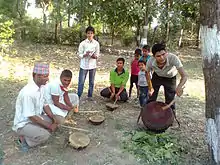दमाइँ | |
|---|---|
 Damai men playing traditional Damaha | |
| Regions with significant populations | |
| 565,932 (1.9% of Nepal's population) (2021)[1] | |
| Languages | |
| Nepali (Khas kura) | |
| Religion | |
| Hinduism 96.59% (2011), Christianity 3.22% (2011)[2] | |
| Related ethnic groups | |
| Khas people, Kami, Badi, Sarki, Gandarbha/Gaine | |
Damai (Nepali: दमाइँ pronounced [dʌmaĩ]; IAST: Damāĩ) is an occupational caste found among Khas people comprising 45 subgroups.[3] Their surnames take after the subgroup they belong to.[4] People belonging to this caste are traditionally tailors[3] and musicians capable of using the naumati baja - an ensemble of nine traditional musical instruments.[4] The term Damai is coined from the musical instrument Damaha. The 1854 Nepalese Muluki Ain (Legal Code) categorized Damai as "Lower caste” category.[5] Thus, the tribal designation of Khas is given only in few context to Kami, Damai and Sarki due to traditional status.[3]
The Government of Nepal abolished the caste-system and criminalized any caste-based discrimination, including "untouchability" in 1963.[6] The country, previously ruled by a Hindu monarchy was a Hindu nation which has now become a secular state.[7] It was declared a republic in 2008,[8] thereby ending it as the Hindu Kingdom with its caste-based discriminations and the untouchability roots.[9]
According to the 2021 Nepal census, Damai make up 1.94% of Nepal's population (or 565,932 people).[10] Damai are categorized under "Hill Dalit" among the 9 broad social groups, along with Kami, Badi, Sarki and Gaine by the Government of Nepal.[11]
Geographical distribution
At the time of the 2011 Nepal census, the frequency of Damai by province was as follows:
- Karnali Province (4.0%)
- Gandaki Province (3.9%)
- Sudurpashchim Province (2.6%)
- Lumbini Province (1.9%)
- Koshi Province (1.8%)
- Bagmati Province (1.4%)
- Madhesh Province (0.2%)
The frequency of Damai was higher than national average (1.8%) in the following districts:[12]
- Parbat (7.5%)
- Myagdi (5.8%)
- Kalikot (5.1%)
- Dailekh (5.0%)
- Baglung (4.7%)
- Doti (4.6%)
- Surkhet (4.6%)
- Mustang (4.4%)
- Bajura (4.2%)
- Jajarkot (4.0%)
- Lamjung (3.9%)
- Dadeldhura (3.8%)
- Gulmi (3.7%)
- Kaski (3.7%)
- Syangja (3.7%)
- Western Rukum (3.7%)
- Rolpa (3.6%)
- Humla (3.5%)
- Tanahun (3.4%)
- Okhaldhunga (3.3%)
- Arghakhanchi (3.2%)
- Eastern Rukum (3.2%)
- Mugu (3.2%)
- Pyuthan (3.2%)
- Achham (3.1%)
- Sindhuli (3.1%)
- Tehrathum (3.1%)
- Gorkha (3.0%)
- Salyan (3.0%)
- Udayapur (2.8%)
- Dang (2.7%)
- Khotang (2.7%)
- Bhojpur (2.6%)
- Dhading (2.5%)
- Jumla (2.5%)
- Nawalpur (2.5%)
- Kanchanpur (2.3%)
- Ramechhap (2.3%)
- Dolakha (2.2%)
- Kailali (2.2%)
- Panchthar (2.2%)
- Sankhuwasabha (2.2%)
- Baitadi (2.1%)
- Chitwan (2.1%)
- Dhankuta (2.1%)
- Jhapa (1.9%)
- Palpa (1.9%)
- Sindhupalchowk (1.9%)
References
- ↑ National Statistics Office (2021). National Population and Housing Census 2021, Caste/Ethnicity Report. Government of Nepal (Report).
- ↑ Central Bureau of Statistics (2014). Population monograph of Nepal (PDF) (Report). Vol. II. Government of Nepal.
- 1 2 3 Whelpton 2005, p. 31.
- 1 2 The Splendour of Sikkim- Culture and Traditions of the Ethnic Communities of Sikkim. Cultural Affairs and Heritage Department, Government of India. 2017. p. 81.
- ↑ Gurung, Harka (2005) Social Exclusion and Maoist Insurgency. Paper presented at National Dialogue Conference at ILO Convention 169 on Indigenous and Tribal peoples, Kathmandu, 19–20 January 2005.
- ↑ Welle (www.dw.com), Deutsche. "Nepal: Deadly caste-based attacks spur outcry over social discrimination | DW | 16.06.2020". DW.COM. Retrieved 2021-02-28.
- ↑ "Nepal king stripped of most powers". CNN. 18 May 2006. Retrieved 18 April 2020.
- ↑ "Nepal votes to abolish monarchy". BBC News. 28 May 2008. Archived from the original on 7 January 2017. Retrieved 18 April 2020.
- ↑ Crossette, Barbara (3 June 2001). "Birenda, 55, Ruler of Nepal's Hindu Kingdom". The New York Times. Retrieved 18 April 2020.
- ↑ National Statistics Office (2021). National Population and Housing Census 2021, Caste/Ethnicity Report. Government of Nepal (Report).
- ↑ "Nepal Census 2011" (PDF).
- ↑ "2011 Nepal Census, District Level Detail Report" (PDF). Archived from the original (PDF) on 2023-03-14. Retrieved 2023-03-20.
Bibliography
- Whelpton, John (2005). A History of Nepal. Cambridge University Press. ISBN 978-0521804707.